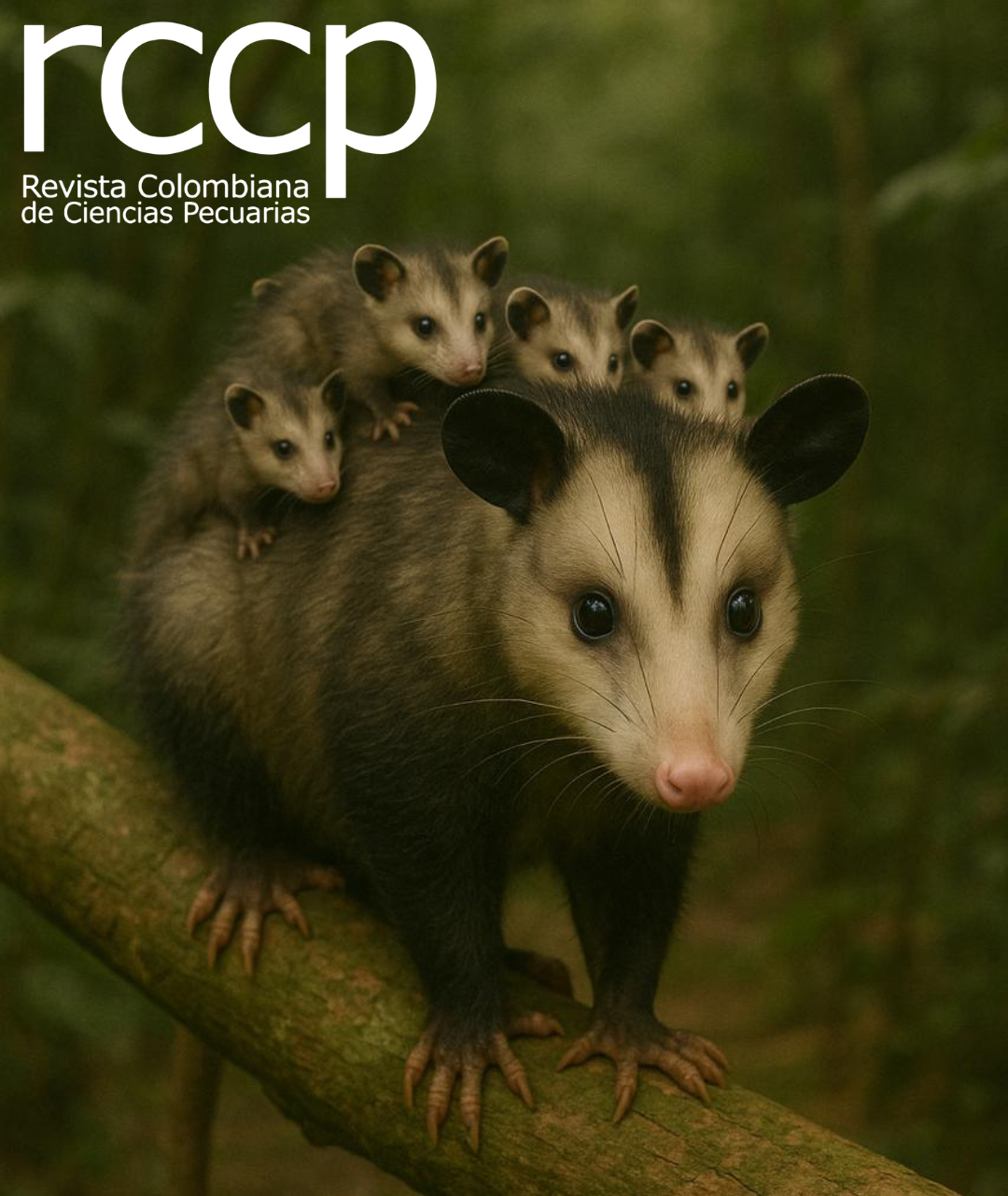Morphology and reproduction of the common opossum (Didelphis marsupialis) dwelling in urban vs rural environments in Antioquia, Colombia
DOI:
https://doi.org/10.17533/udea.rccp.v37n4a1Keywords:
body size, common opossum, Didelphis marsupialis, human-opossum conflict, litter size, marsupial, sexual dimorphism, urban wildlifeAbstract
Background: Although urban wildlife has increased during the last years, the effects of urbanization on wildlife are poorly understood. Common opossum (Didelphis marsupialis) is a frequent dweller of the Metropolitan Area of Valle del Aburrá (AMVA) in the Antioquia province (Colombia) where opossum-human conflicts result in large numbers of injured or dead opossums. Objective: To evaluate the effects of urban and rural habitats on the morphometry and reproductive output (litter size in marsupium) of opossums. Methods: A total of 131 opossums were captured: 94 in the AMVA, and 37 in rural areas of Antioquia. Opossums were weighed, measured, sexed, clinically inspected, and photographed. Results: Urban opossums were heavier and larger than rural individuals, regardless of sex, and no differences were observed in terms of reproductive output between both habitats. Additionally, urban opossums were more abundant than rural opossums, possibly explained by the fact that cities favor survival -through higher food availability- but not reproduction. Alternatively, bigger animals could also be explained by inadequate diets rich in carbohydrates which may also have deleterious health effects. We observed sexual size dimorphism in head and tail length but not in body length of opossums. Conclusion: We confirm that urban environments have a significant effect on body mass and size of opossums; however, it is unknown whether this is beneficial or detrimental for these animals. Finally, we report the lowest litter size for the species, with no difference between rural and urban habitats.
Downloads
References
Adler GH, Arboledo JJ, Travi BL. Population dynamics of Didelphis marsupialis in Northern Colombia. Stud Neotrop 1997; 32(1):7–11. https://doi.org/10.1076/snfe.32.1.7.13462
Auman HJ, Meathrel CE, Richardson A. Supersize me: does anthropogenic food change the body condition of Silver Gulls? A comparison between urbanized and remote, non-urbanized areas. Waterbirds 2008; 31(1):122–126. https://doi.org/10.1675/15244695(2008)31[122:SMDAFC]2.0.CO;2
Bradley CA, Altizer S. Urbanization and the ecology of wildlife diseases. Trends Ecol Evol 2006; 22(2):95–102. https://doi.org/10.1016/j.tree.2006.11.001
Bubadué J, Meloro C, Hendges C, Battistella T, Carvalho R, Cáceres N. Clinal and allometric variation in the skull of sexually dimorphic opossums. J Mamm Evol 2021; 28(2):185–198. https://doi.org/10.1007/s10914-020-09513-w
Cáceres NC. Population ecology and reproduction of the white-eared opossum Didelphis albiventris (Mammalia, Marsupialia) in an urban environment of Brazil. Cien Cult 2000; 52(3):171–174.
Castillo-Contreras R, Mentaberre G, Aguilar XF, Conejero C, Colom-Cadena A, Ráez-Bravo A, González-Crespo C, Espunyes J, Lavín S, López-Olvera JR. Wild boar in the city: Phenotypic responses to urbanisation. Sci Total Environ 2021; 773:145593. https://doi.org/10.1016/j.scitotenv.2021.145593
Cervantes FA, Oviedo-Martínez V. Epipubic bones of the Virginia Opossum (Didelphis virginiana) from México. Therya 2020; 11(1):1–7. https://doi.org/10.12933/therya-20-872
Collins MK, Magle SB, Gallo T. Global trends in urban wildlife ecology and conservation. Biol Conserv 2021; 261:109236. https://doi.org/10.1016/j.biocon.2021.109236
Cordero-Rodríguez GA. The biology of the opossum (Didelphis marsupialis) in urbanized environments from northern Venezuela. Acta Biol Venez 2020; 20(2):13–28.
Cruz-Salazar B, Ruiz-Montoya L, Navarrete-Gutiérrez D, Espinoza-Medinilla EE, Vázquez Domínguez E, Vázquez LB. Genetic diversity and relative abundance of Didelphis marsupialis and Didelphis virginiana in Chiapas, Mexico. Rev Mex Biodivers 2014; 85(1): 251–261. https://doi.org/10.7550/rmb.36116
Flórez-Oliveros FJ, Vivas-Serna C. Zarigüeyas (Chuchas Comunes) Marmosas y Colicortos en Colombia. 1ra ed. Medellín (Colombia): Divergráficas S.A.S.; 2020. ISBN: 978-958-488262-2.
Glebskiy Y, Cano-Santana Z. Comparison of the efficiency and ethical implications of pitfall and Tomahawk traps on Virginia opposums (Didelphis virginiana). Acta Zool Mex 2021;37:1–8. https://doi.org/10.21829/azm.2021.3712375
Lenth R. emmeans: Estimated Marginal Means, aka Least-Squares Means. R package version 1.8.4-1. 2023. https://CRAN.R-project.org/package=emmeans
Magle SB, Hunt VM, Vernon M, Crooks KR. Urban wildlife research: past, present, and future. Biol Conser 2012; 155:23–32. https://doi.org/10.1016/j.biocon.2012.06.018
McIntyre NE, Knowles-Yánez K, Hope D. Urban ecology as an interdisciplinary field: differences in the use of “urban” between the social and natural sciences. Urban Ecosyst 2000; 4:5–24. https://doi.org/10.1023/A:1009540018553
Rodríguez KN, Aguirre DR, Ceballos CP. Experimental protocol to repel opossums (Didelphis marsupialis) through an artisanal odor repellent device. Rev Colomb Cienc Pecu 2022; 35(4):205–216. https://doi.org/10.17533/udea.rccp.v35n4a01
Ryser, JAN. The mating system and male mating success of the Virginia opossum (Didelphis virginiana) in Florida. J Zool 1992; 228(1):127–139. https://doi.org/10.1111/j.14697998.1992.tb04437.x
Schmidt C, Treberg JR, Kinnunen RP, Garroway CJ. Serum biochemistry suggests grey squirrels (Sciurus carolinensis) have poorer physiological condition in urban settings. bioRxiv 2019; 12. https://doi.org/10.1101/2019.12.16.878702
Sunquist ME, Austad SN, Sunquist F. Movement patterns and home range in the common opossum (Didelphis marsupialis). J Mammal 1987; 68(1): 173–176. https://doi.org/10.2307/1381069
Tardieu L, Sundaram V, Adogwa AO, García GW. Anatomy and histology of the gastrointestinal tract of the neo‐tropical opossum (Didelphis marsupialis insularis, Allen 1902). Acta Zoo 2020; 101(4):384–391. https://doi.org/10.1111/azo.12306
Tyndale-Biscoe CH, Mackenzie RB. Reproduction in Didelphis marsupialis and D. albiventris in Colombia. J Mammal 1976; 57(2):249–265. https://doi.org/10.2307/1379686
Wist B, Stolter C, Dausmann KH. Sugar addicted in the city: impact of urbanisation on food choice and diet composition of the Eurasian red squirrel (Sciurus vulgaris). J Urban Ecol 2022; 1(12). https://doi.org/10.1093/jue/juac012
Wright JD, Burt MS, Jackson VL. Influences of an urban environment on home range and body mass of Virginia opossums (Didelphis virginiana). Northeast Nat 2012; 19(1):77–86. https://doi.org/10.1656/045.019.0106

Published
How to Cite
Issue
Section
License
Copyright (c) 2021 Revista Colombiana de Ciencias Pecuarias

This work is licensed under a Creative Commons Attribution-NonCommercial-ShareAlike 4.0 International License.
The authors enable RCCP to reprint the material published in it.
The journal allows the author(s) to hold the copyright without restrictions, and will allow the author(s) to retain publishing rights without restrictions.





